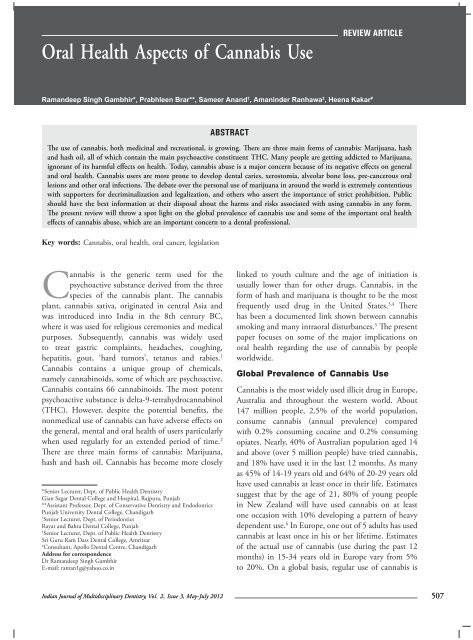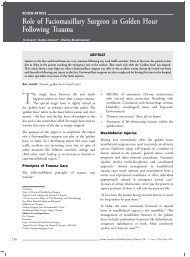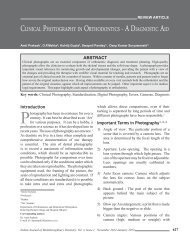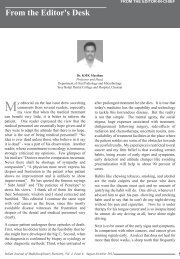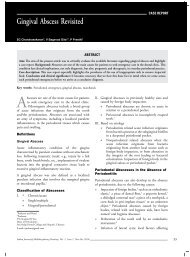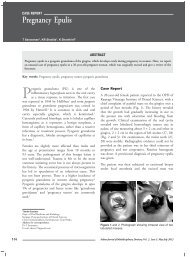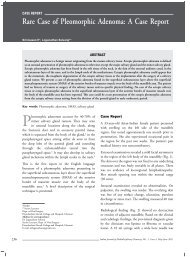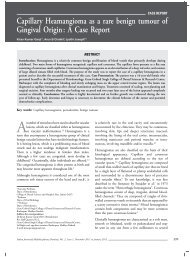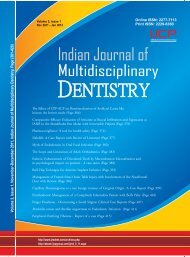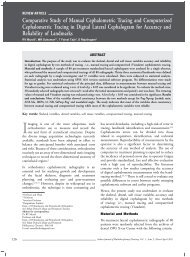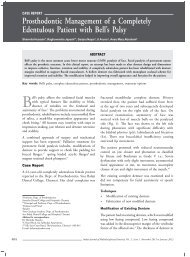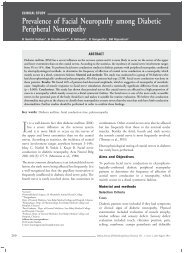Volume 2 - Issue 3 (May-Jul)
Volume 2 - Issue 3 (May-Jul)
Volume 2 - Issue 3 (May-Jul)
Create successful ePaper yourself
Turn your PDF publications into a flip-book with our unique Google optimized e-Paper software.
Oral Health Aspects of Cannabis Use<br />
Review Article<br />
Ramandeep Singh Gambhir*, Prabhleen Brar**, Sameer Anand † , Amaninder Ranhawa ‡ , Heena Kakar #<br />
Abstract<br />
The use of cannabis, both medicinal and recreational, is growing. There are three main forms of cannabis: Marijuana, hash<br />
and hash oil, all of which contain the main psychoactive constituent THC. Many people are getting addicted to Marijuana,<br />
ignorant of its harmful effects on health. Today, cannabis abuse is a major concern because of its negative effects on general<br />
and oral health. Cannabis users are more prone to develop dental caries, xerostomia, alveolar bone loss, pre-cancerous oral<br />
lesions and other oral infections. The debate over the personal use of marijuana in around the world is extremely contentious<br />
with supporters for decriminalization and legalization, and others who assert the importance of strict prohibition. Public<br />
should have the best information at their disposal about the harms and risks associated with using cannabis in any form.<br />
The present review will throw a spot light on the global prevalence of cannabis use and some of the important oral health<br />
effects of cannabis abuse, which are an important concern to a dental professional.<br />
Key words: Cannabis, oral health, oral cancer, legislation<br />
Cannabis is the generic term used for the<br />
psychoactive substance derived from the three<br />
species of the cannabis plant. The cannabis<br />
plant, cannabis sativa, originated in central Asia and<br />
was introduced into India in the 8th century BC,<br />
where it was used for religious ceremonies and medical<br />
purposes. Subsequently, cannabis was widely used<br />
to treat gastric complaints, headaches, coughing,<br />
hepatitis, gout, ‘hard tumors’, tetanus and rabies. 1<br />
Cannabis contains a unique group of chemicals,<br />
namely cannabinoids, some of which are psychoactive.<br />
Cannabis contains 66 cannabinoids. The most potent<br />
psychoactive substance is delta-9-tetrahydrocannabinol<br />
(THC). However, despite the potential benefits, the<br />
nonmedical use of cannabis can have adverse effects on<br />
the general, mental and oral health of users particularly<br />
when used regularly for an extended period of time. 2<br />
There are three main forms of cannabis: Marijuana,<br />
hash and hash oil. Cannabis has become more closely<br />
*Senior Lecturer, Dept. of Public Health Dentistry<br />
Gian Sagar Dental College and Hospital, Rajpura, Punjab<br />
**Assistant Professor, Dept. of Conservative Dentistry and Endodontics<br />
Punjab University Dental College, Chandigarh<br />
†<br />
Senior Lecturer, Dept. of Periodontics<br />
Rayat and Bahra Dental College, Punjab<br />
‡<br />
Senior Lecturer, Dept. of Public Health Dentistry<br />
Sri Guru Ram Dass Dental College, Amritsar<br />
#<br />
Consultant, Apollo Dental Centre, Chandigarh<br />
Address for correspondence<br />
Dr Ramandeep Singh Gambhir<br />
E-mail: raman1g@yahoo.co.in<br />
linked to youth culture and the age of initiation is<br />
usually lower than for other drugs. Cannabis, in the<br />
form of hash and marijuana is thought to be the most<br />
frequently used drug in the United States. 3,4 There<br />
has been a documented link shown between cannabis<br />
smoking and many intraoral disturbances. 5 The present<br />
paper focuses on some of the major implications on<br />
oral health regarding the use of cannabis by people<br />
worldwide.<br />
Global Prevalence of Cannabis Use<br />
Cannabis is the most widely used illicit drug in Europe,<br />
Australia and throughout the western world. About<br />
147 million people, 2.5% of the world population,<br />
consume cannabis (annual prevalence) compared<br />
with 0.2% consuming cocaine and 0.2% consuming<br />
opiates. Nearly, 40% of Australian population aged 14<br />
and above (over 5 million people) have tried cannabis,<br />
and 18% have used it in the last 12 months. As many<br />
as 45% of 14-19 years old and 64% of 20-29 years old<br />
have used cannabis at least once in their life. Estimates<br />
suggest that by the age of 21, 80% of young people<br />
in New Zealand will have used cannabis on at least<br />
one occasion with 10% developing a pattern of heavy<br />
dependent use. 6 In Europe, one out of 5 adults has used<br />
cannabis at least once in his or her lifetime. Estimates<br />
of the actual use of cannabis (use during the past 12<br />
months) in 15-34 years old in Europe vary from 5%<br />
to 20%. On a global basis, regular use of cannabis is<br />
Indian Journal of Multidisciplinary Dentistry, Vol. 2, <strong>Issue</strong> 3, <strong>May</strong>-<strong>Jul</strong>y 2012<br />
507


